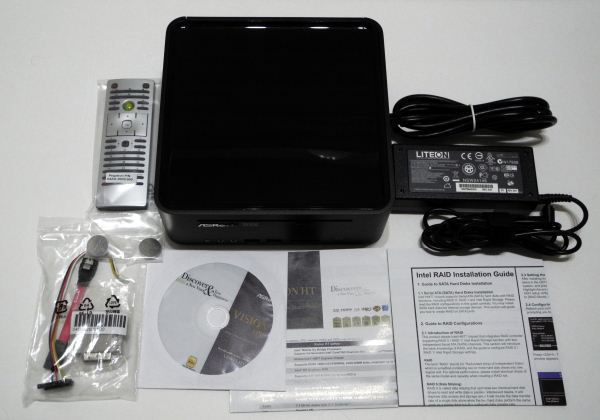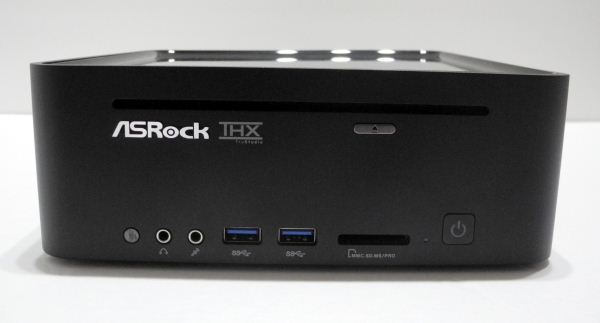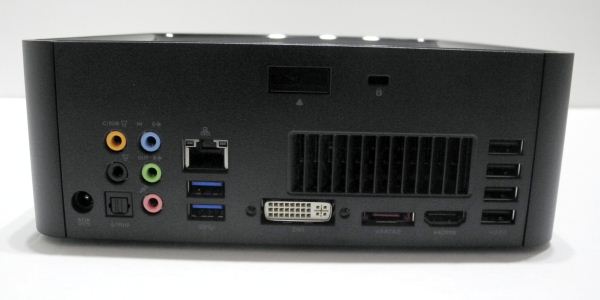ASRock Vision HT: Ivy Bridge Carries the SFF HTPC Forward
by Ganesh T S on November 12, 2012 3:30 PM EST- Posted in
- Home Theater
- ASRock
- HTPC
- Ivy Bridge
Unboxing Impression
The ASRock Vision HT 321B package contained the following:
- Main unit in a 2.5L chassis (195mm x 186mm x 70mm)
- 90W AC / DC adapter
- Media Center remote with batteries
- Support CD with drivers and miscellaneous software
- DVI- VGA dongle
- SATA and power cables / screws for user installation of second hard disk
Unlike the CoreHT 252B, the industrial design of the Vision HT traces its roots to the Vision 3D series. We have pleasing rounded edges, though the chassis doesn’t have a unibody construction. ASRock deserves credit for bringing the industrial design of the high-end units to the mid-range segment this time around.
When compared to the Core HT from last year, we find that the two USB 3.0 ports and the microphone / headphone jack in the front panel are retained. However, the power button changes from a circular version to a square with rounded edges. A SD card reader also makes an appearance. There are no ventilation slots in the front panel this time around.
Just like a notebook, this unit also supports simultaneous display on two monitors. Testing was done mostly with the HDMI output connected to a Sony KDL46EX720 1080p 3D TV through a Pioneer Elite VSX-32 AV receiver. For non-media playing related testing, the HDMI port was connected to an Acer H243H 1080p monitor. Our review unit shipped with Windows 7 x64 Ultimate and a OEM version of Cyberlink PowerDVD for Blu-ray playback. However, the OEM version doesn't support 3D Blu-rays and is also crippled with respect to the number of audio channels that can be decoded / HD audio passthrough. To test these, we installed the full versions of both Cyberlink PowerDVD 12 as well as ArcSoft Total Media Theater 5.
We will conclude this section with a table to summarize the data and A/V connectivity options for the ASRock Vision HT 321B HTPC.
| Option | Status |
|---|---|
| HDMI | Yes [v1.4a] |
| Component | No |
| Composite | No |
| VGA | Yes |
| SPDIF | Yes [Optical] |
| Stereo | Yes |
| Option | Status |
|---|---|
| Optical Disk Drive | Yes [Blu-Ray / DVD-RW] |
| USB | Yes [4 x v2.0, 4 x v3.0] |
| eSATA | Yes [1 x v3] |
| LAN | Yes [ 1000 Mbps GbE ] |
| Internal HDD | Yes [ 500 GB ] |
| WiFi | Yes [ 300 Mbps 2T2R 802.11n (Dual band)] |
| Bluetooth | Yes (v 4.0) |
| Card Reader | No |













40 Comments
View All Comments
Guspaz - Monday, November 12, 2012 - link
The lack of DisplayPort video output is kind of a big deal... DisplayPort is the only output that the Intel HD 4000 supports high resolution (like 2560x1440 or 2560x1600) over. It will not output these resolutions over HDMI or DVI, as the Intel HD 4000 does not support dual-link DVI.As this is a rather severe shortcoming to a user with a 27" or larger monitor, and users may expect support for this resolution since the chip itself does support it, it should be mentioned in the review. Otherwise, a user might buy this computer only to find out that it doesn't support any 27" monitors...
A better approach would have been for Asrock to include a DisplayPort instead of DVI, and then include a cheap passive DP->DVI adapter in the box. Such adapters are very cheap (under $7 from monoprice), so this would have been an enormously more flexible option.
As the system stands, with no option for a videocard slot, this system can never support large displays.
hughlle - Monday, November 12, 2012 - link
The vast majority of users will be using an HTPC with their HDTV, not a "small" high end moniter, so for the majority of users wanting an HTPC, 1920x1080, as in HD resolutions, is what they will be looking for.methudman6 - Monday, November 12, 2012 - link
It could've been marketed as a "PC-Mini" too if it had display port. I find it strange that they market it so strongly as an HTPC when it looks like it'd make a very nice small computer for casual use.Guspaz - Tuesday, November 13, 2012 - link
There is nothing about this system that makes it an "HTPC" except the cheap remote they include with it, and that's something you can add to any computer for a few dollars. It's just as well suited as a general SFF computer except for this issue. Previous Asrock systems in this identical form factor (and I've used a few of the ION ones for media playback at a large convention) didn't even have a remote.Death666Angel - Tuesday, November 13, 2012 - link
But it also seems like an oversight for Intel to not have DVI 2560 output. What did they gain by that omission?Guspaz - Tuesday, November 13, 2012 - link
Pin count, perhaps? Take a look at the respective pin counts, and I'll exclude hotplug, power, shield, ground, reserved, analog (except on VGA), or optional pins, since none of those would have to be routed to the CPU AFAIK.:DVI: 10 pins
DisplayPort: 10 pins
HDMI: 11 pins
VGA: 12 pins
DVI Dual-Link: 16 pins
I may be excluding some pins that do in fact have to be routed to the CPU, but my basic point is that adding dual-link DVI support would have required adding more pins/traces to the processor, socket, motherboard, etc. That's a non-trivial thing, and from Intel's perspective you can use an adapter to get dual-link DVI anyhow (although at $69 from monoprice, the adapter isn't cheap like the $8 single-link DVI adapter is)
deadlockedworld - Monday, November 12, 2012 - link
Apple should sue!! (seriously though, the shape is almost exactly the same as the previous generation mini)Guspaz - Tuesday, November 13, 2012 - link
The Asrock machines are waaay bigger than the Mini, and the Mini wasn't the first to use that form factor (mini ITX boxes predate it). It was the thinnest of them, to be sure, but not the first.IlllI - Monday, November 12, 2012 - link
wonder what ever happened to those. looks like they dont sell them anymoreGrok42 - Monday, November 12, 2012 - link
I cut the cord/dish 6 years ago. My kids have all grown up not having access to normal television programming. I have a WD-Live x2, Roku x3, iPodses, iPads and iPhones all which can basically access the same media including a 6TB NAS drive. I rip all the kids movies to the NAS drive as soon as we buy them which is 90% of what is on the NAS drive other than home movies and photos. I watch movies from NetFlix, Hulu or rent them on Amazon. I love browsing YouTube from the WD-Live for most of the misc stuff.What else does a HTPC bring to the table that the ~$99 WD-Live doesn't do better and for less? The WD-Live is tiny, has no fans and is Velcroed to the back of my entertainment system. It is plugged into a Wireless N router and can stream 1080P movies with ease. The only thing I can think of is that I can't play PC games or Surf; is there something else?
Not a troll, I sort of feel like I'm making this huge mistake not having an HTPC given my setup but I can never figure out why I would want one.